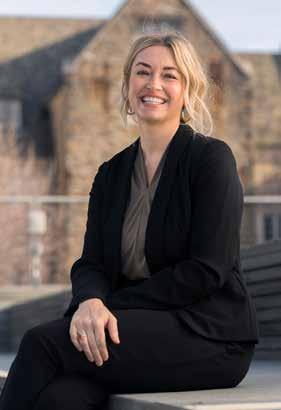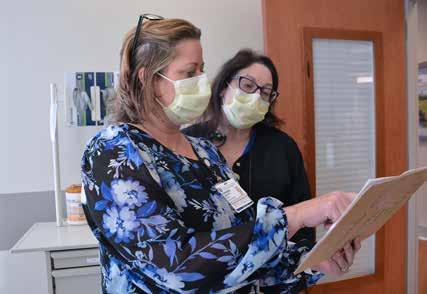A New Era

HYBRID: THE NORM 8 LEADERSHIP COURSES FOR LEARNING 13 SAVE AT THE GYM 15 NEWS YOU CAN USE • APRIL/MAY 2023
Welcome, new colleagues – all 21,401 of you!
The cover image for this month’s issue of Working@Duke is incredibly special.
We invited Duke University and Duke University Health System staff and faculty who were hired since the pandemic to send us their headshot to help illustrate the front cover for the feature story, “A New Era.”
The feature story is about Duke’s post COVID-19 workforce – how nearly half of it is new, hired since the pandemic started in 2020. The story explores how Duke is attracting and retaining talent in a competitive landscape, while lifting up aspects of workplace culture that must endure.


We received 525 headshots, more than what we could fit in the space on the front cover, so we carried pictures to pages 4 through 7. In all, you’ll see 220 headshots on the front cover and another 20 on pages 4-7, reflecting our diverse workforce.

One new colleague, whom you’ll see atop the row on page 4, is ZiYan Britt, who joined Duke in February of this year. She’s a senior clinical research specialist for Duke University School of Medicine.

In her role, Britt collects research data from neurosurgery inpatients by going through cognitive tasks with them. She also processes MRI and CT images for analysis and keeps documentation of research activities up to date, along with subject data.
She has dreamed of being affiliated with Duke since she was a student at Grovetown Middle School and Grovetown High School in Grovetown, Georgia, and wants to one day attend Duke University School of Medicine “to learn medicine from the best.”

“No matter where I go, if someone else from Duke sees my badge or learns of my affiliation, they greet me like a friend,” said Britt, 23. “Even though it’s only been a few weeks, I am seeing how the Duke community sticks together and supports each other.”
I want to express my gratitude to everyone who submitted a headshot for this latest issue. While we were only able to fit 300, the engagement is truly inspiring. It speaks to the resiliency of our community, and to the passion of our newest members.
I am proud to be a part of a diverse community of long-time employees, new colleagues, and all others in between, that is constantly evolving, even in the face of unprecedented challenges. Your willingness to enthusiastically share your stories is a testament to the strength of our collective spirit.

4 10 8
4 A New Era
Since the pandemic, Duke has hired 21,401 new staff and faculty – a figure that represents nearly half of the workforce. While the job turnover rate is lower than the average rate predicted for U.S. employers, Duke has had to reimagine how to attract and retain top talent in a competitive landscape.
8
Hybrid: The Norm
According to a Working@Duke survey, 39 percent of Duke University and Health System employees work remotely one-to-four days each week.

10
Catch Up on Retirement Savings
As you save for your future, there are at least three things to keep in mind.
Paul Figuerado (919) 684-2107 paul.figuerado@duke.edu
Stephen Schramm Senior Writer (919) 684-4639 stephen.schramm@duke.edu
Jack Frederick Writer (919) 681-9965 jack.frederick@duke.edu
Working@Duke is published quarterly by Duke’s Office of Communication Services. We invite your feedback and story ideas. Send email to working@duke.edu or call (919) 681-4533.
2 WORKING@DUKE Editor’s Note LEANORA MINAI WORKING@DUKE CONTENTS
11 Building a culture of encouragement 12 Infertility treatment provides the benefit of a family 13 Leadership learning courses for 2023 14 Working Toward Racial Justice: Sharing the story of progress 15 Fitness membership savings 2017, 2014 Gold, 2019, 2015, 2013, Silver, 2016, 2009, 2007 Bronze, Print Internal Audience Publications and 2012, 2011, 2009, 2008, 2007 Gold Medal, Internal Periodical Staff Writing Visit Working@Duke daily on Duke Today: working.duke.edu Executive Director of Communications/Editor Leanora Minai (919) 681-4533 leanora.minai@duke.edu Assistant Vice President: Paul S. Grantham (919) 681-4534 paul.grantham@duke.edu Graphic Design & Layout:
Contact us
Cover: The front page includes 220 headshots of Duke University and Duke University Health System staff and faculty who joined Duke since the start of the pandemic. Each page from pages 4-7 includes 20 headshots of new colleagues. Photos are courtesy of staff and faculty.
BRIEFLY
Changes to COVID-19 Protocols
COVID-19 immunity through vaccination or natural infection has increased to about 90 percent of Duke’s population, which has led to a steep decline in cases and severe illness.
As a result, Duke leadership announced changes to COVID protocols in an email to staff, faculty, and students in late March. Here are some of the changes:
Masking: Masking on Duke buses and vans is now recommended but will no longer be required. Masking remains required in all patient-care and clinical settings and for anyone who is symptomatic and around others, regardless of location or test results.
Surveillance Testing: The remaining surveillance test sites ended operations before spring break. Symptomatic testing will continue on campus through Student Health or the Employee Exposure Hotline, 919-385-0431, option 1.
Rapid Antigen Tests: At-home antigen tests are available through the Duke Stores’ Service Desk in the Bryan Center. One test kit per week is available at no charge to anyone with a valid DukeCard.
SymMon App: The SymMon app used for reporting symptoms or test results will be retired in April. Employees can use the My COVID Link [coronavirus.duke.edu/testing] to report symptoms or test results.
“As has been the case throughout the pandemic, these changes are based on the data, trends and science,” wrote Dr. Carol Epling, executive director of Employee Occupational Health and Wellness (EOHW); Dr. John Vaughn, assistant vice president for Student Affairs and Student Health director; and Dr. Cameron R. Wolfe, associate professor of medicine. “We acknowledge the possibility that a new COVID variant could change the current trends and require us to modify our approach regarding vaccination, masking and other safety protocols.”
Stay informed at coronavirus.duke.edu
Get Help Finding Your Strengths

Learn how to make the most of the tools you have with the “CliftonStrengths Finder: Discover Your Greatest Talent!” course offered by Duke Learning & Organization Development (L&OD).
The new course is a three-hour online session organized around a 177-question self-assessment that will construct a picture of your patterns of thinking, feeling, and behaving, and it will show you which of the 34 CliftonStrengths themes apply to your set of talents.
The course is designed to leave participants feeling inspired, encouraged, and ready to make the most of their new self-awareness.
“The CliftonStrengths Finder is a wonderful self-assessment, which allows participants to see why they can do some parts of their job really well, and why some parts of their job are not in their wheelhouse,” said Joy Birmingham, the associate director for L&OD who leads the course. “Once you know this about yourself, you can focus on building your talents into strengths and using them to help yourself work around your weaknesses.”
The next sessions are June 8 and October 26. For more information, visit hr.duke.edu/training
Duke Farmers Market Opens April 27

Staff and faculty can get ahead on grocery shopping each week at the Duke Farmers Market, which starts April 27 and runs through Sept. 28.
Organized by LIVE FOR LIFE, the Duke employee wellness program, the market is available every Thursday from 11 a.m. to 2 p.m. on the Duke Medicine Pavilion Greenway outside of the Trent Semans Center for Health Education.
Last year, the farmers market returned for the first time since the start of the pandemic as an event held twice per month.
“Employees can shop for whatever they like, and support a local vendor,” said Brandon Harper, health promotions manager for LIVE FOR LIFE. “That’s a really cool opportunity for employees.”
Ten cash-only vendors – including local Gabor Farms and Lyon Farms – will appear weekly at the market, selling a variety of goods, including produce, jellies and jams, milk, flowers, coffee, and baked goods. Bulkogi Food Truck, Korean barbecue based in Durham, and Vic’s Pizza Truck, which sells New York-style pizza by the slice or pie, will be on site each week.
LIVE FOR LIFE staff members will be available to help attendees connect with other health and wellness resources.
Find more information at hr.duke.edu/farmersmarket
Discount Tickets to the Carolina Flyers
Cheer on one of the Triangle’s championship professional sports teams and save with discounted tickets to the American Ultimate Disc League’s Carolina Flyers.
Established in 2015 and competing in the AUDL’s South Division against teams from Austin, Dallas and Houston, the Carolina Flyers won the league championship in 2021. The Flyers play six home games at Durham County Memorial Stadium on April 29, May 13, May 21, May 26, June 16, and July 15.

Staff and faculty of Duke University and Duke University Health System can get 20 percent off the regular adult ticket price.
Kids 12 and under are free. For more information and the discount code, visit duke.is/68sdv and log in with your Duke NetID.

working.duke.edu 3
A New Era
Nearly 21,500 new staff and faculty have been hired at Duke since the pandemic
The first time Joseph Salem visited Duke University in 2017, he knew it was a special place.
Duke was one of three universities Salem, then associate dean at Penn State University, visited as part of a fellowship program with the Association of Research Libraries. Salem was taken by the beauty of Duke’s campus and impressed by the way university leaders described the recently renovated libraries as the intellectual heart of the institution.
“Duke was the only school that I left and thought, ‘Wow, I would love to come here,’” Salem said.
In late 2022, Salem returned to Duke as the Rita DiGiallonardo Holloway University Librarian and Vice Provost of Library Affairs, where he oversees six libraries and a collection of 8.5 million volumes.

“I wasn’t actively on the market because I was very happy at Michigan State,” said Salem, former dean of libraries at Michigan State University. “But when the opportunity at Duke came up, I remembered advice I’d gotten to always go for your dream job.”
Salem is among the 21,401 new staff and faculty Duke University and Duke University Health System have hired since the beginning of 2020 – a figure that represents nearly half of the workforce. Given the scale of research, education and health care operations, Duke has traditionally had a high number of annual hires. But the number of new employees in recent years has trended up, with most hires refilling positions opened by departures or retirements.
The upheaval caused by COVID-19 led to widespread change in how, why, and where many Americans work. Work location flexibility and a reexamination of individual priorities have contributed to an increased number of workers across the country changing jobs since 2020.
While Duke’s job turnover rate is lower than the average rate predicted for U.S. employers, Duke has had to reimagine how to attract and retain top talent in a competitive landscape, while defining pieces of its workplace culture that must endure.
“Duke has a long history of being able to reinvent itself, but as we reinvent ourselves, we still have to stay true to who we are fundamentally,” said Antwan Lofton, vice president for Duke Human Resources. “Our core missions are to serve our patients, educate our students and create a workforce free from discrimination. While our workforce is changing, we need to make sure that Duke remains the top destination for talented people who want to be part of this important work.”
For employees such as Salem, who was drawn to Duke by the opportunities offered, and for staff and faculty who have chosen to stay, each person has a story of why, during a time of transition, Duke is where they belong.
New Hires
4 WORKING@DUKE
Joseph Salem, the Rita DiGiallonardo Holloway University Librarian, center, views the opportunity to lead Duke’s libraries as a “dream job.” Photo: Duke University Libraries.
Due mostly to refilling job openings created by departures, as well as a small degree of growth, Duke has seen its number of total hires rise in recent years. The total employee headcount for Duke University and Duke University Health System was 38,591 in 2017 and 42,887 in 2022.
Source: Duke Human Resources
Duke University and Health System 2017 2018 2019 2020 2021 2022 6,208 6,375 6,902 6,220 6,989 8,192
Recruiting the Best
Duke University Environmental Services Utility Worker Jay Royal finds plenty to appreciate during his 3-11:30 p.m. shift keeping the Brodhead Center clean. He loves the youthful energy of students, the camaraderie with colleagues, and the salmon and mashed potatoes from Sprout, an eatery in the Brodhead Center.
Housekeepers rank sixth among the most-hired positions across Duke since 2020. Royal became one of them in April 2022 when, after working for two months in a temporary position, he was offered a full-time role. It was the second time that the Durham-born Royal, has worked at Duke. He worked in housekeeping in 2015 but left Duke for another role. In the years since, benefits from other employers fell short of what Duke offered, he said.

“I was praying to get back here,” said Royal, who cherishes Duke’s time off and retirement plan benefits.
Royal knew what made Duke a special place to work but making that case to other candidates in the post-pandemic landscape isn’t as simple since the competition for talent has intensified in recent years. According to Duke Human Resources, the number of overall hires Duke made last year represents a 32 percent increase compared to 2017.
In addition to housekeeping, other job areas at Duke that have seen the most hires include nursing and research-related roles.
Denise Motley, assistant vice president for Duke Human Resources, Central Recruitment and Staffing, said that a desire for flexible work locations and the emergence of fully remote work forces Duke to vie with other employers from across the nation for candidates.
“There’s a whole new level of competition,” said Motley, whose team of recruiters has expanded to address hiring needs.
Duke isn’t alone in welcoming a high number of new faces. According to the Bureau of Labor Statistics, there were roughly 10.3 million hires made in the education and health services field in 2022. That’s up from roughly 8.6 million hires in 2019.
“That trend is up across the board, among all types of positions, from administrators to non-exempt staff members,” said Andy Brantley, president and CEO of the College and University Professional Association for Human Resources (CUPAHR). “It’s true for all employers, but especially for higher education, we are in a recruitment and retention crisis.”
Retaining Caregivers
Perhaps nowhere at Duke is the challenge of recruiting and retaining team members greater than in nursing and clinical support roles, which are among the positions that have seen the highest number of voluntary departures and new hires since the pandemic. This is a national crisis, as a 2022 national survey by the American Nurses Association shows that 52 percent of nurses are considering leaving their position because of stress and burnout.
Duke University Health System is focused on ways of supporting team members who have been working on the front lines throughout the pandemic.
Rhonda Brandon, Duke University Health System chief human resources officer and senior vice president, said that, with a health system workforce that is 60 percent millennial or Gen Z, the desire for more flexibility, clearer pathways to advancement and competitive wages make it more challenging to find and keep talent.
To counter those trends, Duke has increased its minimum wage and invested in salaries of front-line staff; expanded the Employee Tuition Assistance Program, including shortening the eligibility waiting period; enhanced clinical ladders to support growth; and strengthened workplace safety by increasing the security presence and
working.duke.edu 5
>>> continued on page 6
Utility Worker Jay Royal. Photo by Justin Cook.
adding weapons detection systems across its hospitals. Brandon said Duke is also working on ways to redesign and simplify team members’ work to reduce stress and burnout.
“We want our team members to have joy in their work and to feel valued, seen and heard,” Brandon said. “We want everyone to know that they matter and they belong here as we work together to deliver extraordinary care.”
Aastha Baral, a clinical nurse III in Duke Regional Hospital’s mother-baby unit, knows she belongs at Duke.

Baral joined the Duke Regional staff in 2019 after working at other hospitals in North Carolina. In addition to a generous retirement savings plan offered by Duke, Baral was attracted to opportunities to grow professionally.
With help from Duke’s RN Tuition Assistance Program, which covers up to 90 percent of tuition for eligible Duke nurses attending the Duke University School of Nursing, Baral will earn her Master of Science in Nursing degree in 2024.
Beyond the tangible benefits, Baral said the warm and welcoming culture of Duke Regional Hospital makes her want to stay. She can’t go far in the hospital’s corridors without a greeting from a colleague. Even under masks, smiles are commonplace.
The tight-knit spirit shined through in February of 2022, when Baral and her husband, Anup, welcomed their daughter, Maeve. While pandemic safety protocols made an office baby shower impossible, Baral received cards and flowers while on maternity leave from the Duke Regional colleagues who wanted to celebrate her growing family.
“There’s a good culture here. I have a good manager, a good support system and great coworkers,” she said. “I also love the work.”
Fostering Duke Culture
While Dr. Althaf Hussain joined the Duke Human Vaccine Institute (DHVI) as senior director of product development in late 2022, he’d long known about the DHVI’s team-first culture and the science it produces.

While working with the Centers for Disease Control and Prevention (CDC) years ago, Hussain got to know DHVI Director Dr. Barton Haynes, a pioneering HIV researcher. During the pandemic, Hussain, then working for a Triangle-based pharmaceutical firm, saw how DHVI scientists worked together to confront a quickly evolving novel coronavirus.
Since its founding in 1990, DHVI has been defined by teams of immunologists, computational biologists, structural biologists, virologists and biochemists using open minds and innovative approaches to overcome hurdles. Hussain wanted to be a part of that collaborative spirit.
“To be where I can enable the ideas of brilliant scientists is a rare thing,” said Hussain, who shepherds potential vaccines from lab to clinical trial. “It’s a fantastic opportunity.”
No matter how defined a team’s culture is, maintaining it in a time of shifts is a challenge. Due to replacing
6 WORKING@DUKE
Dr. Althaf Hussain.
Photo by Justin Cook.
Duke Regional Hospital Clinical Nurse Aastha Baral. Photo by Justin Cook.
voluntary departures and growth from new projects – many related to COVID-19 – roughly a quarter of DHVI’s 300 team members have been hired since 2020.
Thomas Denny, chief operating officer of DHVI, said the institute has tried to nourish its interconnected nature through staff-led team-building events and healthy lines of communication between staff and leadership. He said that ensuring new hires share Hussain’s appreciation of collaboration is an essential piece of keeping the synergistic spirit intact.
“No one person can do it,” Denny said. “We have to be aligned.”
Ashleigh Shelby Rosette, senior associate dean of Executive Programs and the James Vincent Professor of Leadership at Duke’s Fuqua School of Business, said that it’s important for employers to introduce new hires to the culture of their organization as soon as possible.
By understanding the values, beliefs and expectations, new employees will have a better chance to thrive, Rosette said. But it’s also useful to let new employees have a say in shaping culture moving forward.
“An organization’s culture must be accommodating, and perhaps even somewhat malleable, when large shifts in its workforce take place,” Rosette said. “This does not imply that the core values and beliefs of an organization should change. It does suggest that the way those values are implemented may need to evolve as new faces arrive in the organization.”
Post-Pandemic College Life
Finding a balance between embracing existing culture and moving fresh ideas forward is something Duke’s new employees must consider.
In August 2022, Sara Pratt Peacock, associate dean of students and director of DukeReach, joined Duke’s Office of Student Affairs, which supports over 16,000 undergraduate, graduate and professional students.

Last year, Student Affairs welcomed 94 new staff members, mostly in dining, housekeeping, student health care, and venue and event operations roles.
Peacock leads DukeReach, a student case management program that connects students to on- and off-campus resources that help them navigate challenges. For the previous nine years, Peacock led a similar student case management program that she helped start at Coastal Carolina University.
“I was very familiar with DukeReach; it was really a pioneer in this field,” Peacock said. “The opportunity to work at a place as distinguished as Duke doesn’t happen every day. And with my familiarity with DukeReach specifically, and my appreciation for everything it has contributed to the field, I felt like this was a great fit.”
Peacock has worked on getting to know Duke’s student culture by volunteering at campus events such as National Coming Out Day and the move-in weekend party on West Campus, and meeting with students and colleagues at hubs such as the Bryan Center Plaza.
On nice days, she might bring her bike to work to familiarize herself with Duke’s geography while pedaling between West Campus and her East Campus office in the Crowell Building.
And while she’s getting used to where she is, Peacock is exploring where her team’s work can go. As post-pandemic college life comes into focus with different challenges and new opportunities to connect, Peacock is looking forward to seeing how DukeReach can evolve.
“It’s exciting to work in higher ed, and at Duke, at a time when there’s a lot of change,” Peacock said. “It’s an opportunity to be creative and maybe build something new.”
By Stephen Schramm
working.duke.edu 7
Sara Pratt Peacock. Photo by Justin Cook.
Hybrid: The Norm
For Heather Moffitt, work location flexibility is a big draw of her job at Duke.
On the two days when she works from home in Siler City, Moffitt, a program coordinator at the Fuqua School of Business, doesn’t wake up at 5:30 a.m. for the one hour and 15-minute commute to campus. Instead, she diverts the newfound time to her dogs, Logan and Ella, and gets started earlier on work tasks.
“Working hybrid is the way to go,” said Moffitt, who joined Duke last year. “You get the best of both worlds. Having the option to work from home allows me to keep the job I love and my sanity.”
Moffit is among the 39 percent of Duke University and Duke University Health System employees who work remotely one-to-four days each week, according to a Working@Duke survey in December 2022.
To assess work location desires of staff and faculty, Working@Duke conducted an online poll for the third consecutive year. Of the nearly 2,900 employees who responded, 45 percent prefer to work fully remote each week, slightly higher than 2021, while 6 percent favor no remote work, also slightly higher. Thirty-four percent of employees who responded to the survey work fully remote.
Employees continue to rank the lack of a commute and flexibility among the top benefits of remote work. Setting boundaries between work and life is the top challenge, followed by social isolation.
Working@Duke survey results track Gallup data, which indicates that the majority of remote-capable employees in America work a hybrid (53 percent) or exclusively remote (26 percent) arrangement.
Antwan Lofton, vice president of Duke Human Resources, said that since the pandemic, Duke has established a foundation for work location flexibility for non-patient and student facing roles, and that now, leaders of schools, departments and units will continue to assess roles that fit for hybrid or remote arrangements.
“I do believe that hybrid work is here to stay,” Lofton said. “That said, while we understand people are being very productive while working from home, there are certain things that you still get out of being surrounded by your peers.”
Across Duke, employees prefer a hybrid or remote arrangement, but a portion of the community still prefers to be on-site.
Fully Remote – from New York
Before the pandemic, Nicole Durrick couldn’t imagine working for Duke. But since last year, she has contributed to patient care and research while living about 700 miles from campus, at the base of the Adirondack Mountains in New York.
Durrick, an advanced grants and contracts administrator, is among the 34 percent of Duke employees who work fully remote – either in North Carolina or from one of Duke’s approved states, according to the Working@Duke survey. She is among at least 468 employees – a 200 percent increase since 2020 –who reside outside of North Carolina but work for Duke.


Last summer, Duke expanded the number of states where exempt faculty and staff can work to provide flexibility and support recruitment and retention. While New York was already on the list, Duke added others states, bringing the total number to 17, as well as Washington, D.C.
Durrick, whose team includes colleagues in Texas, Florida, and North Carolina, joined Duke from Rensselaer Polytechnic Institute, where she worked for 21 years, nearly all on-site. She stumbled on a job opening online and was drawn to Duke by professional development opportunities that help her manage 38 active grants and numerous grant applications for Duke doctors. In the past year, she has participated in the Research Administration Academy at Duke, which connects staff members with hands-on training to develop grant management skills. In her unit, she feels supported by colleagues, who are willing to jump on Zoom to answer questions.
Heather Moffitt
8 WORKING@DUKE
Nicole Durrick
Hybrid or fully remote work is preferred by Duke employees, according to a recent survey
“I definitely have the work-home life balance that is needed, but then I have a great team and great managers,” Durrick said.
Favors the Campus Charm
Kelly Umstead supports online learning for the Master of Business Administration daytime program at the Fuqua School of Business. Except for technical support in a classroom, most of his work can be done remotely, but Umstead prefers to come to campus each day.

Umstead represents the 6 percent of employees who favor not working remotely at all, according to the Working@Duke survey.
“I am old school and prefer separating my job from my home, and I work from home only if absolutely necessary,” said Umstead, who has worked at Duke for 32 years.
When at home, he misses the view from his fifth-floor office that looks out over the left field of Jack Coombs Field, where he sees the sun rise. And on campus, he gets to hear the toll of the Duke University Chapel bells as he walks to his car at the end of a day.
“I like being on campus, and it’s important to have faceto-face time with my awesome teammates,” said Umstead, who works on a team that maintains approximately 200 course websites per year. “To me, that’s part of the charm and uniqueness of the job.”
Future of Work
Starting a fully remote role when she joined Duke last year, Jackie Okoh had few opportunities to see students or meet colleagues.
As the undergraduate program administrator for the Department of Computer Science, Okoh comes to campus on Mondays and Wednesdays each week to manage payroll
How Many Days Per Week Duke Employees Work Remote

documents and build community through in-person social events that bring together students in the department.
“It has helped financially with gas and car maintenance expenses,” said Okoh, who was able to move into a larger apartment.
Okoh is among 39 percent of Duke employees who work remote one to four days each week, according to the Working@Duke survey. She represents the hybrid work model preferred by nearly half of Duke employees.

“I like hybrid work because you still have a sense of workplace community, in terms of engaging with your coworkers and your colleagues,” Okoh said. “I just think being able to visually see people helps you feel more acclimated to normal because we weren’t really normal for a while.”
By Jack Frederick
Share your work location story and photos: write working@duke.edu
One day 10% Two days 10% Three days 11% Four days 8% Five days 34% Not at all 27%
Kelly Umstead
working.duke.edu 9
Jackie Okoh
According to a Working@Duke survey, 39 percent of Duke University and Duke University Health employees work remotely one-to-four days each week. Source: Working@Duke, December 2022.
Catch Up on Retirement Savings
Move closer to goals with special contribution limits and expert advice
Eileen Williams’ clinical social work career has left her soul full, but prior to joining Duke’s staff in 2021, her retirement savings weren’t as robust.

After moving her savings to Duke’s 403(b) Faculty and Staff Retirement Plan, Williams, who is nearing retirement age, has been thrilled to see her retirement savings grow.
“If I had an opportunity to be in a plan like this 10 or 15 years ago, I wouldn’t be in catch-up mode now,” Williams said.
A Bankrate survey shows that 55 percent of Americans are behind on retirement savings with nearly 35 percent saying they’re “significantly behind.”

Duke’s retirement plans help employees save for and secure their future. The Faculty and Staff Retirement Plan allows all employees to save for retirement and provides a Duke contribution to eligible salaried or monthly paid staff and faculty. The Employees’ Retirement Plan (ERP) is a pension plan paid for entirely by Duke for hourly or bi-weekly paid staff.
In the 2021-22 fiscal year, Duke contributed a combined $224.7 million to both retirement plans.
“The Duke contributions are significant, but a big part of your retirement comfort is going to depend on you saving to whatever extent you can,” said Johanna Zawada, associate director of Benefits for Duke Human Resources.
As you save for your future, here are three things to keep in mind.
Enroll and Contribute
Through payroll deduction, all Duke employees, whether paid monthly or hourly, can contribute anywhere from 1-to-80 percent of each paycheck to the Faculty and Staff Retirement Plan account.
Experts suggest contributing a portion of your pay – starting with at least 3 percent each pay period – and increasing the amount each year to roughly 15 percent or more each pay period, if possible.

Duke contributes to the Faculty and Staff Retirement Plan for all eligible salaried or monthly paid employees regardless of whether they contribute on their own. Roughly 27 percent of eligible salaried or monthly-paid employees are not contributing to their account.
“Your own savings, to supplement Duke’s contribution, will help you meet your retirement goals,” Zawada said.
Catch-Up
Internal Revenue Service rules for 2023 state the maximum annual contribution amount allowed to a 403(b) account – including both pre-tax and Roth contributions – is $22,500. For those over 50, the IRS maximum allowed 403(b) contribution jumps to $30,000 per year.
Employees with 15 years of service at Duke may contribute another $3,000 per year to their 403(b) account provided they meet certain requirements. Call the Human Resources Information Center at (919)-684-5600 to learn more.
Consult Experts
Get complimentary guidance from experts at Fidelity, the primary record keeper of Duke’s retirement accounts, with webinars and one-onone consultations about investment strategies and more.

“Let’s put a plan together,” said Yvette Mills, Fidelity’s workplace financial consultant. “Now is the time to do what needs to be done.”
Visit fidelity.com/duke to schedule a consultation.
By Stephen Schramm
When starting your retirement savings journey, here are recommended percentages of each paycheck you should put toward retirement based on age. Source: Fidelity.
Learn about Duke’s retirement plans: hr.duke.edu/retirement
10 WORKING@DUKE
Duke Regional Hospital’s Eileen Williams has been able to catch up with her retirement savings with Duke’s plan. Photo by Stephen Schramm.
Building a Culture of Encouragement

By supporting a colleague’s growth, Duke Blood Cancer Center creates a spirit of togetherness
Mary Beth Christen recalls a day a few years ago when she came to work feeling overwhelmed.
The stress of raising two daughters, handling the procedural manager role in the Duke Blood Cancer Center’s treatment room, and pursuing her bachelor’s degree in nursing were weighing on her.

Christen’s experience with her Duke Blood Cancer team shows how, when team members feel invested in one another’s success, an environment where employees feel motivated to grow is created.
Sim Sitkin, the Michael W. Krzyzewski University Professor in the Fuqua School of Business, said that these kinds of encouraging cultures are hallmarks of successful organizations.
“You want people to feel comfortable taking initiative, because they know their colleagues value and respect them,” Sitkin said. “Their colleagues know they’re not perfect, but they see them as growing, so they’re willing to stick their neck out for them. In a healthy organization, people accept a certain sense of responsibility for helping those around them.”
A 2022 McKinsey consulting firm survey shows that one of the top five qualities people who recently left jobs were looking for in their next stop were supportive and reliable colleagues.
With opportunities to develop her skills, and colleagues who nurture each other’s ambition, Christen knows she’s found a special place at Duke Blood Cancer Center. In her unit, personal and professional growth is a team effort.
One coworker, now-retired nurse Sue Roth, pulled her aside.
“Mary Beth, you’re like The Little Engine That Could,” Roth said, referencing the popular children’s book about a determined steam engine. “You can do this. Just keep going.”
In the 11 years since Christen joined the unit, she has moved into a managerial role, completed multiple professional certifications, earned a bachelor’s degree, and will earn a master’s degree in nursing later this year.
But Christen didn’t travel this professional development path alone. From supportive coworkers, such as Roth, to supervisors who regularly pushed her to take on new challenges, the encouraging culture created by her colleagues provided an ideal environment for career ambitions to flourish.
“We’ve always been supportive and excited to see people try to be their best,” said Jennifer Frith, clinical operations director for the Duke Blood Cancer Center. “If you enjoy coming to work, and you feel supported, you’re going to stay. If you’re happy at work, a lot of pieces fall into place.”
“We’ve always supported each other,” Christen said. “The value of that is immeasurable. Having someone come and put their hand on your shoulder and support you means so much.”
By Stephen Schramm
Share Your Story
As the post-pandemic work landscape evolves, Working@Duke will share stories of how individuals, schools, departments, and units build a positive culture at Duke. Share your story by writing us: working@duke.edu
working.duke.edu 11
The Duke Blood Cancer Center’s Jennifer Frith, left, and Mary Beth Christen, right, are part of a team that encourages growth and fellowship. Photo by Stephen Schramm.
Providing the Benefit of a Family
Certain Duke medical plans include infertility treatment for employees with two continuous years of service
When Meghann Koffi arrived at Duke in 2008, she was single, in her early 20s and had recently relocated from Ohio.
Two years later, she met Cole when they both volunteered for a photography contest at a festival in Cary. After the contest, they spent the rest of the afternoon wandering the festival together, not ready to part ways.
“We’ve pretty much been hanging out together ever since,” said Koffi, a human resources specialist with the Department of Psychology and Neuroscience.
They got married in 2013 and, about a year later, felt ready to start a family. Falling in love was easy. Getting pregnant was not, so Koffi began researching options for infertility treatment.

As a Duke employee with more than two years of continuous service, Koffi found that her Duke Select medical plan covered aspects of infertility treatment – offered to eligible staff and faculty since the 1980s – through the Duke Fertility Center.
Staff and faculty members with at least two years of continuous service based on their most recent hire date with Duke can receive coverage for infertility treatments by enrolling in either the Duke Select or Duke Options medical plans. Members of Duke Select or Duke Options who live in North Carolina get their treatments through the Duke Fertility Center.
In a new enhancement starting in 2023, Duke Options members who live outside of North Carolina receive coverage for infertility treatment from approved in-network providers.
“Duke has always had a stateof-the-art benefits plan,” said Antwan Lofton, Duke’s vice president for Human Resources. “Whether it’s fertility benefits, parental leave, lactation spaces or elder care, we’ve always tried to find ways to help employees wherever they may be in their lives.”
Under the Duke plans, infertility services include a co-pay based on a packaged group of services. For controlled ovarian hyperstimulation or a frozen embryo transfer, the co-pay is $800. For in vitro fertilization (IVF), there’s a co-pay of $5,000 to $5,500 per cycle, depending on treatment. According to the Society for Assisted Reproductive Technology, the average cost of one IVF cycle is between $10,000-15,000 in the U.S. For Koffi, Duke Fertility Center doctors found the right medication to give her a more reliable ovulation cycle. And in February of 2016, Koffi gave birth to son, Noah.
“We were ecstatic, just over the moon,” said Koffi, who welcomed a second son, Evan, in 2019, following more treatment, including intrauterine insemination, at Duke Fertility Center.
With her Duke coverage, Koffi said that, for both of her pregnancies, the total out-of-pocket cost for the fertility treatments and prescriptions was around $2,000.
“I’m forever grateful,” Koffi said. “I know some people try and try and aren’t able to start a family the way they’d like to. I’m lucky to be somewhere with benefits that allowed me to be where I am today and have this family.”
By Stephen Schramm
For Duke’s infertility treatment benefit eligibility, visit hr.duke.edu/benefits/medical

12 WORKING@DUKE
Meghann Koffi, center, was able to use Duke’s benefits to become a mother to Noah, left, and Evan, right. Photo courtesy of Meghann Koffi.
Leadership Learning for Any Role
Attend a professional development class to enhance leadership skills
Rev. Racquel Gill, minister of Intercultural Engagement at Duke University Chapel, often talks with her supervisor about the importance of leading at work from within.
When she discovered a course from Duke Learning & Organization Development (L&OD) called “SelfLeadership – Growing Your Career & Self Awareness,” she enrolled to seek growth as a leader, both personally and professionally.
“You really have to learn to lead yourself and manage yourself,” Gill said.
Offered next on June 28, the selfleadership course is among several L&OD offerings for individual contributors and managers who want to grow skills and stay relevant at any experience level.
“Leadership is not something reserved for a position,” said Joy Birmingham, L&OD associate director. “If we can understand that, we can change Duke across the board.”
Here are several leadership courses offered by L&OD in 2023.
Critical Thinking
“CriticalThinking Skills: Strategies for Improving” was crucial for helping Jimmy Goodwin take on
more responsibility as a foreman in the Engineering & Operations Carpentry Shop.
The course, offered next on Aug. 10, helped him learn strategies for how to analyze information, make decisions, and communicate – key skills for his work. Goodwin and nine carpenters make service calls across Duke University Hospital and clinical spaces to repair doors, flooring, and drywall.

“It helps you connect with everyone, and it makes your job easier,” said Goodwin, who joined Duke in 2020. “The more you learn, the more it can help you communicate with everyone.”
Valuing Differences
Offered on June 22 and Sept. 27, “Valuing Differences” is a new course about nurturing intercultural competence as a framework for leveraging difference in workplace relationships.
Gina Rogers, course instructor and associate director of L&OD, said the course will help participants better understand respect and social identity, key aspects for fostering an inclusive workplace.
“Building upon the knowledge, skills and capacity for myself, improves my self-awareness and better positions me for engaging well with others,” Rogers said.
Managing Multiple Priorities
Staff assistant Jeremy Boomhower works on a small team that supports faculty in the Department of Gender, Sexuality and Feminist Studies.
Last year, he took “Managing Multiple Priorities” because he wanted to hone strategies for time management. The course, offered next on May 17, helped Boomhower realize that he needed a formal to-do list. He installed a whiteboard by his desk, and it helps him set a daily schedule and priorities.

“When I walk in my office, I can look straight at it and scribble down what I need,” he said. “And then I can erase it as I go.”
By Jack Frederick
Professional Development
Review L&OD courses and start your journey: hr.duke.edu/training
working.duke.edu 13
Jeremy Boomhower uses a white board to track his to-do list. Photo by Jack Frederick.
Toward Racial Justice Sharing the Story of Progress
Through the Diversity Action Alliance, Duke communicators further inclusion
In 2020, a series of killings of unarmed citizens brought the nation’s systemic racism into focus. Across the country, and at Duke, people reflected on how racial inequality shapes life and what actions could move society in a more equitable direction.

That desire led to the creation of Duke’s chapter of the Diversity Action Alliance, a coalition of public relations and communications industry associations and leaders working to accelerate achievements in diversity, equity, and inclusion in the communications profession. Duke was the first higher education institution to join the alliance, which was created in 2019.
“The urgency people felt came from the recognition that these issues have been around for a really long time,” said Andrew Park, Duke Law School associate dean for communications, marketing and events, and Duke’s Diversity Action Alliance chapter co-chair, with Terri Laakso, general manager for e-commerce at Duke Stores. “That recognition leads you to say ‘What can we do? What can we get done?’”
By 2021, as Duke’s chapter grew to around 50 communicators across Duke, various subcommittees were focusing energy on projects producing tangible steps toward diversifying the ranks of Duke’s communications professionals and ensuring stories told reflected the institution’s diversity.
Since then, Duke’s communicators have worked to understand the challenges communicators of color face at Duke by analyzing data from the 2021 Duke Campus Climate Survey and listening to focus groups of communicators from underrepresented minorities. They’ve also organized focus groups with North Carolina Central University students participating in Duke’s communications internship program to learn how Duke, and other workplaces, can be more inclusive.
A new mentoring program, which connects diverse earlycareer communicators, as well as staff members considering a communications career, with more experienced colleagues at Duke, is finishing its first full year of operation. Communicators have also produced an online catalog of resources for inclusive communications and an ethical imagery guide offering insights on how to make visual communication inclusive.
The mentorship program has helped Sheriece Smith expand her skills. As an administrative assistant in the Office of the Provost since 2022, Smith’s role includes elements of communications with event planning and new faculty orientation.

In a previous role with the government of the British Virgin Islands, Smith gained experience writing speeches and news releases. Now with mentor Cat de Montjoye of the Duke Health & Fitness Center, Smith is expanding her knowledge of marketing.
“Communications and media is ever-changing, so there are always things to learn,” Smith said.
This spring, the work of the Diversity Action Alliance chapter at Duke continues. One subcommittee is planning opportunities for communicators to hear from diversity experts, while another is working on an audit tool to help communicators assess diversity represented in their work.
“There’s the saying that ‘representation matters,’ and it truly does,” said Diversity Action Alliance member Bernadette Gillis, a senior news writer for the Duke University School of Medicine’s Office of Strategic Communications. “It’s important to see people that look like you represented in the workplace, in the classroom, in the lab. We’re here. We’re all here.”
By Stephen Schramm
Learn about Duke’s Diversity Action Alliance chapter: communicators.duke.edu/daa
14 WORKING@DUKE
Sheriece Smith of the Office of the Provost has enjoyed the opportunity to expand her skills through a mentorship program. Photo by Stephen Schramm.
Fitness Membership Savings
Kathryn Williford enrolled in a membership at the A.E. Finley YMCA so that she and her husband, Derek, could take their sons, Logan, 3, and Cole, 7, to the outdoor pool.

But she soon realized how much more the family could enjoy, including soccer and basketball leagues, a summer camp and childcare area, where her children could play under supervision while she and her husband exercised.
“It’s obviously helpful if you have fitness goals you’re trying to attain or specific health goals, but it’s also helpful as a family,” said Williford, a nurse manager at Duke Primary Care Brier Creek Family Medicine. “It’s a great community resource to meet people, get involved with different events and they have tons of classes, regardless of what you’re interested in.”
Using the “Duke Fitness Club” discount through LIVE FOR LIFE, Duke’s employee wellness program, staff and faculty save on memberships to fitness facilities, including O2 Fitness, YMCA of the Triangle, Life Time Fitness, and more. Campus facilities such as Wilson and Brodie and the Duke Health & Fitness Center are part of the program, too.
“One of the big benefits is that there are so many options for gyms people can join,” said Stacy Rankin, LIVE FOR LIFE’s fitness program manager. “No matter where you live
in the local area, you’re going to have a gym close by through Duke Fitness Club, so it’s definitely convenient.”
In addition, all employees save on Wellbeats, which costs $5 per month. The on-demand fitness provider has nearly 300 online classes that range from one to 50 minutes. Classes are divided into 22 channels including circuit and strength training, yoga, Pilates and more.
LIVE FOR LIFE manages the enrollment process to Wellbeats and facilitics in the program. Once you join, LIVE FOR LIFE coordinates convenient and secure payroll deduction for membership fees, which vary depending on the facility.
Williford, like all staff and faculty who join a branch in the YMCA of the Triangle, received a waived enrollment fee for membership.
About a year ago, Williford started working with a personal trainer for an extra fee at the A.E. Finley YMCA to help her strengthen muscles and lessen knee and lower back pain. She has gained body strength and settled into a fitness routine.
“It’s really helped my confidence level walking into the gym,” Williford said. “Even if I’m going on my own, I know what to do and how to work the machines and focus on different muscle groups.”
By Jack Frederick
Learn about Duke Fitness Club at hr.duke.edu/fitness or call 919-684-3136, select option 1.
Staff and faculty receive discount rates to gyms
working.duke.edu 15
Kathryn Williford with sons, Logan, left, and Cole. Photo by Jack Frederick.
What you’re sharing
Duke
Heart @DukeHeartCenter
Unicorn Parade. Cath Us If You Can. Cirque De Sore Legs. Check out some fun team names in the annual Get Moving Challenge, which ends this week. http://ow.ly/fHUQ50NgF8N @DukeLibraries
The Duke Employee Elder Care Consultation Service is a free benefit with resources and answers when caring for elders.







dukeglobaled Congratulations to Heidi! Her Pomegranate Ricotta Cheesecake Tart won this year's annual Pi Day competition.

82 likes


Your Next Career Step
“Your Career at Duke” is a series of no-cost, hour-long live webinars for all Duke University and Duke University Health System employees.


Share story ideas by emailing working@duke.edu Connect with Working@Duke on Social Media Duke University Office of Communication Services 705 Broad St., Durham, N.C. 27708 DUKE SOCIAL
Instagram instagram.com/workingatduke Facebook facebook.com/WorkingatDuke Twitter twitter.com/WorkingatDuke
online to discover more News You Can Use:
in Pics
the popular cherry allée to other trees around campus, see
spring shines.
online
Go
Duke
From
where
Get Support for Aging Family Members
dukeglobaled Duke University
Way to go, team! Each of you serves as an excellent model of incorporating fitness into your day - for our patients, your families, and peers. Proud of you! 12:49 PM • Mar 14, 2023
Working@Duke @WorkingatDuke • Mar 13
@DukeHeartCenter @DukeHealth #HealthyDuke











































